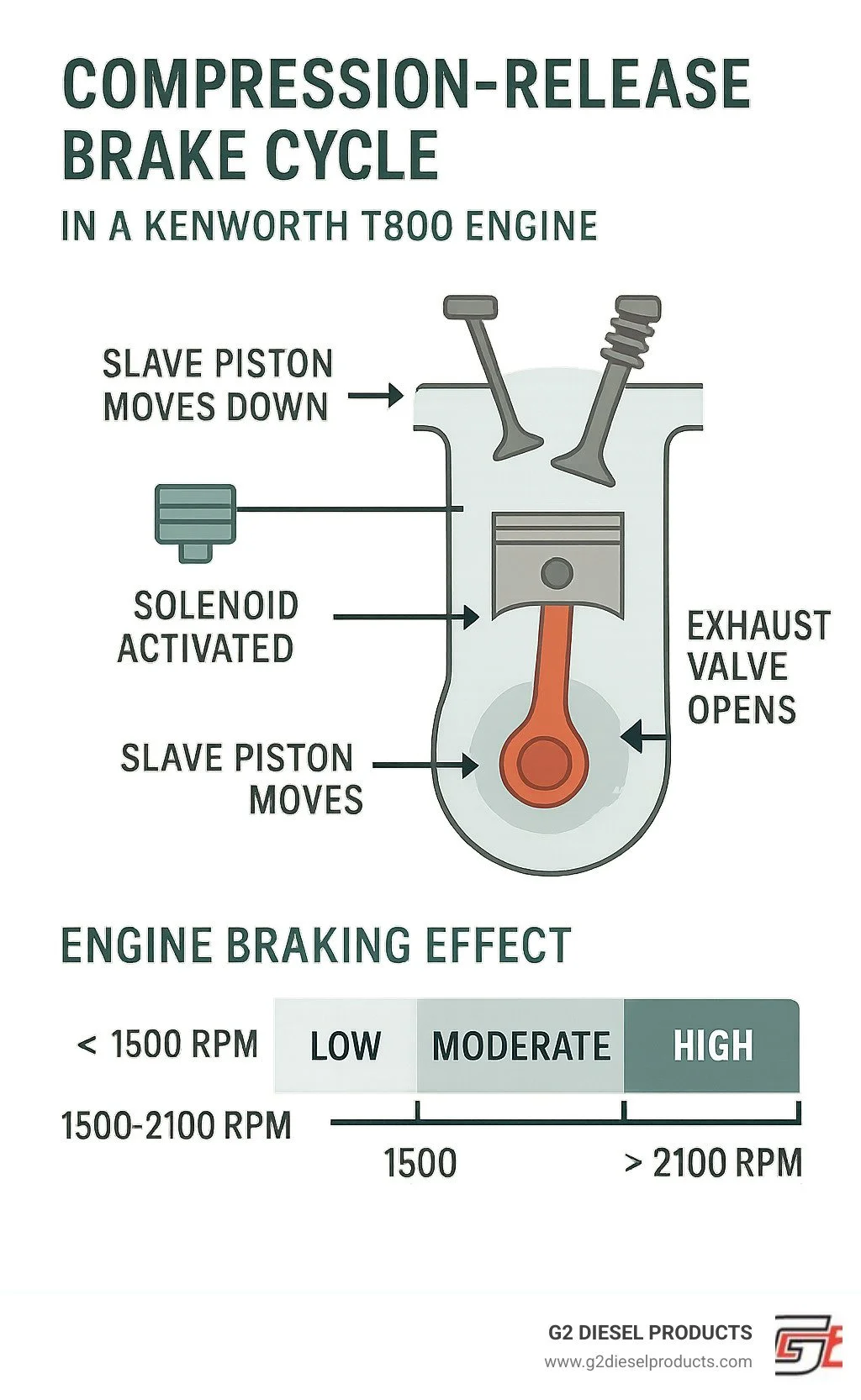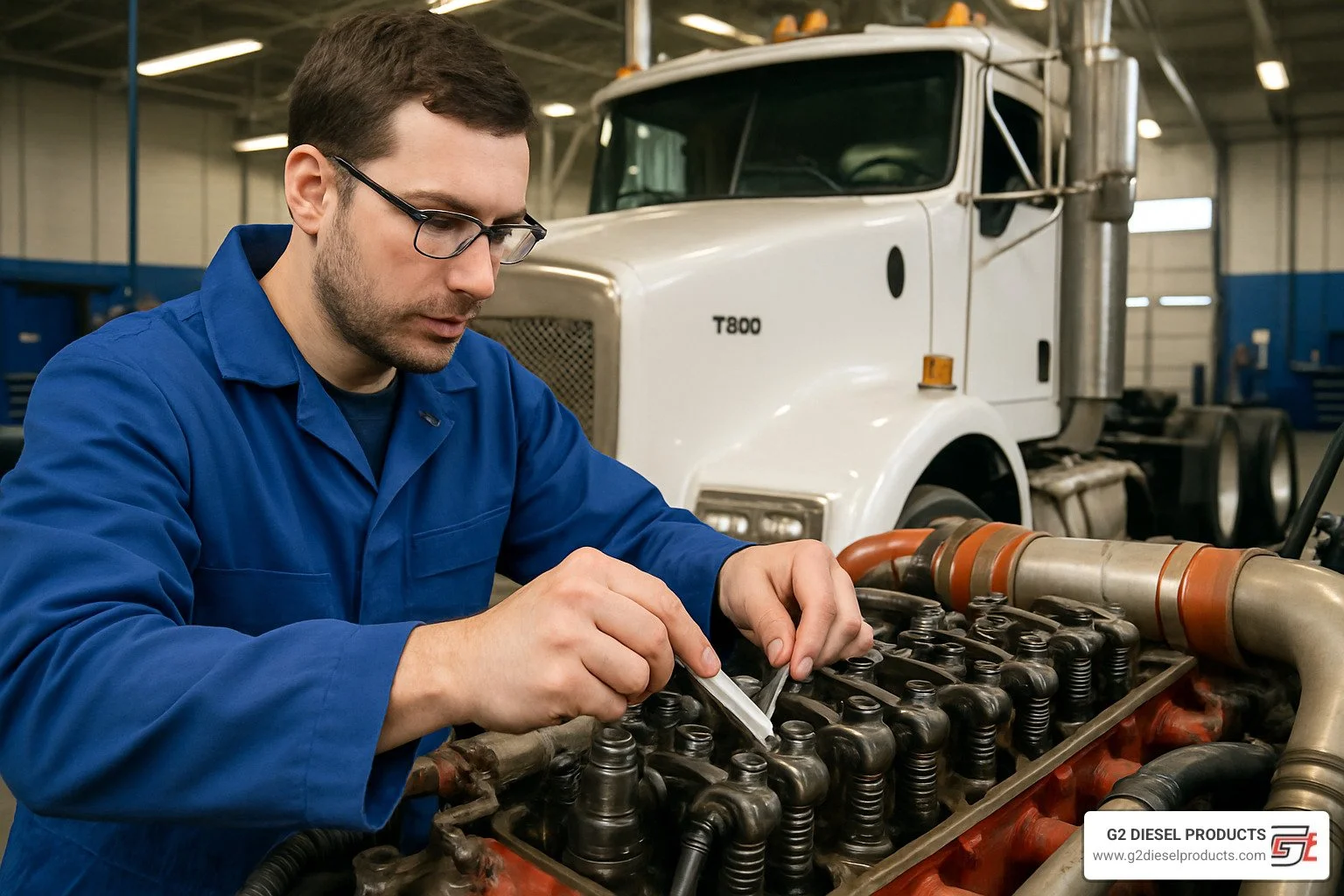Mastering the Kenworth T800 Engine Brake System Without Breaking a Sweat
The Power Behind Safe Slope Descent
Kenworth T800 engine brake components are essential parts that work together to provide crucial supplementary braking power without using the service brakes. If you're looking for a quick overview of these components, here's what you need to know:
Component Function Location Slave Pistons Apply pressure to exhaust valves Engine cylinder head Control Solenoids Activate brake system Top of engine Control Module Manages brake engagement Engine management system Dashboard Switch Allows driver control (off/low/medium/high) Driver console Hydraulic System Transfers force to slave pistons Throughout engine Wiring Harness Connects electrical components Engine compartment
The Kenworth T800's engine brake system, commonly known as a Jake brake, is a powerful tool that transforms your heavy-duty truck's engine into an effective braking mechanism. When properly maintained, these components can reduce service brake wear by up to 80% on downhill descents and provide as much as 600 braking horsepower of stopping power.
"Driving safer doesn't happen by accident," as Bendix aptly puts it. For fleet managers and owner-operators alike, understanding the engine brake system is critical not just for safety, but for extending component life and reducing maintenance costs.
The engine brake works by opening exhaust valves near the top of the compression stroke, releasing compressed air and creating a powerful braking effect. This system integrates seamlessly with your T800's electronic control systems to provide controlled deceleration exactly when you need it.
Whether you're navigating the steep grades of mountain passes or managing heavy loads on long hauls, mastering your T800's engine brake components will significantly improve your vehicle's control, safety, and overall operating costs.
Why This Guide Matters
Understanding the Kenworth T800 engine brake components isn't just for mechanics. As drivers and fleet managers, having a solid grasp of this system directly impacts:
Longevity: Properly maintained engine brakes can extend the life of your service brakes by years
Cost Savings: Reducing wear on friction materials means fewer replacements and less downtime
Compliance: Many jurisdictions have specific regulations about engine brake use and maintenance
Safety: Mastering engine braking techniques provides greater control in challenging driving conditions
When we at G2 Diesel Products talk with customers in Harrisburg, PA and across the country, we consistently hear how proper engine brake maintenance has saved them thousands in service brake replacements. One fleet manager told us, "Once our drivers really understood how to use the engine brake system properly, our brake shoe replacements dropped by nearly 65%."
Understanding the Kenworth T800 Engine Brake (Jake Brake)
When you're hauling 80,000 pounds down a 6% grade, your Kenworth T800 engine brake components become your best friends. This remarkable system—affectionately known as the "Jake Brake" after Jacobs Vehicle Systems who pioneered it—transforms your power-generating engine into a powerful braking force.
Imagine being able to control that massive T800 on steep mountain descents without riding your service brakes until they glow red-hot. That's the magic of engine braking. On trucks equipped with the PACCAR MX-13 engine, this system delivers an impressive 600 braking horsepower of retarding power—enough to keep your rig in check on even the steepest grades.
According to scientific research on heavy-duty brake maintenance, proper integration of engine braking can dramatically extend the life of your service brakes while improving overall safety.
How Does the Jake Brake Work?
The beauty of the Kenworth T800 engine brake components lies in their neat simplicity. When you flip that dash switch, you set off a chain reaction that harnesses physics to slow your truck.
Your engine normally runs on a four-stroke cycle—intake, compression, power, and exhaust. The Jake Brake cleverly interrupts this cycle at a critical moment. When your piston reaches the top of its compression stroke, instead of letting that compressed air push the piston back down (creating power), the system briefly opens the exhaust valve. This releases the compressed air through the exhaust system, effectively robbing the engine of its power stroke.
What makes this so effective? By releasing that compressed air, you're forcing the engine to work against itself. Each cylinder becomes an air compressor that absorbs energy from your drivetrain rather than adding to it. The more cylinders you have, the stronger the braking effect.
It's like turning your power plant into a power sponge—absorbing momentum rather than creating it. And it happens dozens of times per second, creating that distinctive "machine gun" rumble that announces a heavy truck managing its descent with authority.
Engine Brake vs Exhaust Brake
Not all supplementary braking systems are created equal. While your T800 likely came equipped with a compression-release engine brake, it's worth understanding how it differs from an exhaust brake system.
An exhaust brake works by creating back-pressure in your exhaust system. It essentially puts a restriction in the exhaust flow, making it harder for the engine to push out exhaust gases. This creates a modest braking effect, typically around 150-200 braking horsepower. They're quieter than Jake Brakes and often simpler to install as aftermarket equipment.
In contrast, your compression-release engine brake (Jake Brake) delivers up to 600 braking horsepower by releasing compressed air at precisely the right moment. While it's louder and more complex, the superior braking power makes it the preferred choice for heavy loads and steep terrain.
Many professional drivers will tell you that having both systems is ideal—using the quieter exhaust brake in noise-sensitive areas and the more powerful Jake Brake when you need maximum retarding force on challenging descents.
The Kenworth T800 engine brake components represent some of the most refined engineering in the trucking industry. When properly maintained, they provide the confidence to tackle any grade safely while extending the life of your service brakes by thousands of miles. As one veteran driver put it, "I'd sooner drive without a radio than without my engine brake."
Kenworth T800 Engine Brake Components Deep Dive
Let’s pop the hood and take a closer look at the hardware that turns your T800’s power-plant into a first-class retarder. Think of these parts as the unsung heroes of every downhill run—working hard so your service brakes don’t have to.
Brake Housing & Rocker Assemblies
The brake housing and its rocker assemblies form the mechanical heart of the system. The precision-cast housing bolts directly to the cylinder head and carries lubrication passages that must stay perfectly clean. Inside, hydraulic slave pistons push on specially machined rocker arms whenever the engine brake is engaged.
Proper torque matters: most housings call for 85–95 ft-lbs on the mounting bolts (check your service manual for the exact figure). Even a small torque error can hurt braking performance or shorten component life.
Solenoids, Harnesses & Control Wiring
On the electrical side, 12-volt solenoids route pressurised oil to the slave pistons. Depending on model year and engine, you’ll see either two-stage (LOW/HIGH) or three-stage (LOW/MED/HIGH) setups. Harsh under-hood heat and vibration mean connectors deserve a regular once-over—look for corrosion, brittle insulation, or pins that won’t seat fully.
The dash switch sends your command, but the ECM does the heavy lifting. It watches RPM, throttle position, vehicle speed and clutch status before giving the solenoids the green light.
Manufacturers & Model Compatibility
Component design depends heavily on the engine in your T800:
• PACCAR MX-13 engines use an integrated three-stage brake that can deliver up to 600 bhp of retarding force.
• Cummins ISX models typically run a two-stage Jacobs arrangement.
• Older Caterpillar blocks rely on Cat-specific rockers and housings that are not interchangeable with newer designs.
Always order by engine model, year and serial number. Two trucks that look identical from 20 feet away can have very different internals under the valve cover, a point our parts desk in Harrisburg stresses daily.
When you understand what each component does and how it fits into the bigger picture, maintaining the system becomes a straightforward part of your regular service routine. A healthy engine brake means cooler drums, happier linings and far less white-knuckle time on the steeper grades.
Integration with Service Brakes and Electronic Safety Systems
The real magic of a Kenworth T800 appears when its engine retarder works in harmony with the conventional brakes and modern electronic controls. This team approach gives you more stopping power, better stability and longer component life.
Air Disc & Drum Brake Synergy
Whether your T800 runs air-disc brakes, traditional drums or a mix of both, the retarder absorbs the lion’s share of the energy on long grades. That keeps service brakes cooler and eliminates the brake-fade panic many drivers remember from the “pre-Jake” era.
“I remember before I understood engine braking properly,” shares Mike, a T800 owner from western Pennsylvania. “I’d come down those Appalachian grades riding my service brakes, and by the bottom, they’d be smoking. Now I barely touch them—the engine brake does the heavy lifting.”
In real-world terms, pairing the retarder with the service brakes can cut stopping distance by up to 20 % and reduce lining wear as much as 80 %. Because the retardation force is applied through the driveline, weight is distributed more evenly across the axles, improving stability on curves and slick pavement. For more information, check out the official Kenworth T800 braking overview: https://www.kenworth.com/trucks/t800.
Electronic Controls & ABS Logic
Modern T800s are rolling computers. The ECM continuously monitors RPM, wheel speed, throttle position and clutch status. If the ABS senses wheel slip it can momentarily disable the retarder on specific axles to keep the rig straight and true.
The system also disengages automatically when RPM drops below about 1,000 rpm, when the throttle opens, or when traction control intervenes. On newer models, hill-start assist briefly uses the engine brake to hold the truck while you transition from the brake pedal to the accelerator—a tiny detail that makes heavy haul work feel far less stressful.
As one veteran driver told us at a recent truck show near our Harrisburg facility: “These new systems are like having an experienced co-driver constantly watching your back. They don’t take over—they just make sure you have the tools you need exactly when you need them.”
Maintenance, Troubleshooting, and Aftermarket Upgrades
Keeping the retarder healthy is straightforward once you understand the timetable and the common pain points.
Recommended Service Intervals
Synchronise engine-brake checks with every oil change, because clean oil is what operates those slave pistons. Valve-lash adjustment is critical; verify it at 100,000–150,000 miles (or sooner if you run mountain routes). Around 250,000 miles, schedule a full inspection: solenoids, wiring, control valves and piston travel. Finally, re-torque housing bolts about 50,000 miles after any top-end work.
Diagnosing Common Issues
• Weak or uneven retardation: start with valve-lash and hunt exhaust leaks.
• No braking at all: check dash switch, fuses and harness grounds; scan the ECM for fault codes.
• Odd noises: rattles suggest something has come loose, while clicks without braking usually point to solenoids.
Always rule out simple causes before diving deep—loose grounds and sticking connectors are still the top culprits our Harrisburg shop sees every month.
Upgrading Components & Ordering Correct Parts
When it’s time to refresh hardware, accuracy is everything. Order by engine model, serial number and CPL to avoid painful returns. OEM components guarantee compatibility, but quality aftermarket kits (including those we stock at G2 Diesel Products) often provide improved solenoids, updated control modules or higher-capacity slave pistons.
Retrofit kits for older trucks can add multi-stage functionality and noticeably more braking power. Whatever route you choose, document part numbers and installation dates; the paper trail simplifies any future troubleshooting.
For a deeper dive into heavy-duty brake maintenance, visit https://www.fleetmaintenance.com/equipment/brakes-tire-and-wheel/article/21264563/breaking-down-heavyduty-air-brake-maintenance or explore our fulfilment solutions at https://www.g2dieselproducts.com/fulfillment-solutions-volvo-mack-kenworth-paccar-diesel-fuel-injectors.
Benefits, Performance Gains, and Safety Best Practices
Proper care and smart use of the retarder pay dividends in three big areas: service-brake life, fuel economy and driver confidence.
Extending Service Brake Life
A Pennsylvania fleet we work with moved from quarterly to annual brake jobs after teaching drivers to rely on the engine brake. Lining life can stretch by up to 80 %, translating into $7,500–$15,000 in savings over a million-mile lifecycle.
Fuel Economy & Driver Comfort
Avoiding service-brake drag typically nets a 1–2 % fuel-economy bump. Drivers also report far less leg fatigue—coming down Cabbage Mountain without heating up the drums is a lot easier on body and mind.
Modern hardware is quieter too; correct adjustment keeps that familiar “machine-gun” rumble to a respectful growl that won’t wake up every house in town.
Operating Safely on Steep Grades
Pick your gear before cresting the hill, aim to stay in the 1,500–2,100 rpm sweet spot, and engage the retarder before speed starts to run away. The “10 mph buffer” rule—setting a target speed at least 10 mph below your maximum safe speed—gives you margin if conditions change.
Remember the FMCSA’s recommended following distance (one truck length for every 10 mph) and don’t be shy about using pull-outs to cool the brakes on very long descents.
As a 30-year veteran driver reminded us: “The engine brake is a tool; thinking ahead is the real skill.”
Frequently Asked Questions about Kenworth T800 Engine Brakes
What are the signs my engine brake components need replacement?
Persistent valve-lash drift, uneven braking, solenoid clicks without retardation, delayed engagement and unexpected oil consumption are all red flags. Modern ECMs will also flash a warning lamp if they see an electrical or hydraulic fault.
Can using the engine brake improve fuel economy?
Indirectly, yes. By reducing service-brake drag and allowing you to manage momentum more smoothly, most operators see a small (1–2 %) fuel-efficiency gain over time. On the downhill side of a grade, the retarder maintains speed without the accelerate-brake-accelerate cycle that wastes fuel.
How do I select the correct replacement parts?
Start with the VIN, engine model, serial number and CPL. Cross-reference the OEM part number, verify torque specs and make sure the new hardware matches the stage configuration (two-stage vs. three-stage) already on the truck. When in doubt, call a Kenworth parts department or our team at G2 Diesel Products—we’re happy to help.
Conclusion
Mastering the Kenworth T800 engine brake components is more than just technical knowledge—it's an investment in safety, efficiency, and your truck's longevity. When you understand how these components work together, you're equipped to make decisions that will pay dividends for hundreds of thousands of miles.
At G2 Diesel Products, we've seen how proper component care transforms vehicle performance. While our specialty is crafting high-quality diesel fuel injectors, we understand that every system on your Kenworth T800 contributes to its overall reliability and performance. That's why we're passionate about helping drivers and fleet managers understand critical systems like the engine brake.
Remember these essential points from our guide:
Regular maintenance of your engine brake components deserves the same attention as any other engine system. Those valve adjustments and solenoid checks aren't just boxes to tick—they're investments in your safety on those long mountain descents.
The techniques you use when operating your engine brake make all the difference. That sweet spot of proper gear selection and proactive engagement not only keeps you safer but extends the life of your entire braking system. As one driver told us, "My brake shoes thank me every time I use my engine brake correctly."
The true magic happens in how your engine brake works alongside your service brakes and electronic systems. This team approach to braking gives you more control, more stopping power, and more confidence on challenging roads.
Catching small issues early saves big money later. That slight change in braking performance might seem minor now, but addressing it promptly could prevent a costly roadside breakdown.
When replacement time comes, taking the extra time to verify you're getting exactly the right parts for your specific engine configuration pays off in performance and reliability.
Whether you're navigating the rolling hills around our Harrisburg headquarters or hauling heavy loads across mountain passes, your well-maintained engine brake system stands ready as a trusted partner in your journey. It's not just about stopping power—it's about confidence, control, and the peace of mind that comes from knowing your equipment won't let you down when you need it most.
After all, in trucking as in life, it's not just about how fast you can go—it's also about how safely you can stop.



